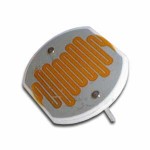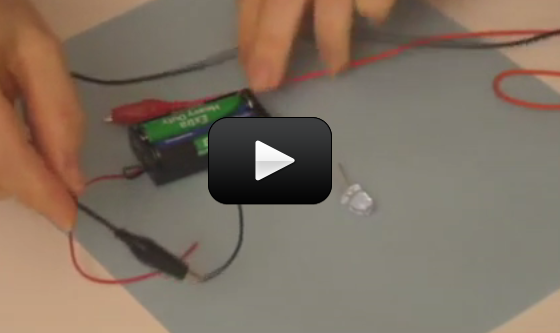 This is a super-cool and ultra-simple circuit experiment that shows you how a CdS (cadmium sulfide cell) works. A CdS cell is a special kind of resistor called a photoresistor, which is sensitive to light.
This is a super-cool and ultra-simple circuit experiment that shows you how a CdS (cadmium sulfide cell) works. A CdS cell is a special kind of resistor called a photoresistor, which is sensitive to light.
A resistor limits the amount of current (electricity) that flows through it, and since this one is light-sensitive, it will allow different amounts of current through depends on how much light it "sees".
Photoresistors are very inexpensive light detectors, and you'll find them in cameras, street lights, clock radios, robotics, and more. We're going to play with one and find out how to detect light using a simple series circuit.
Materials:
- AA battery case with batteries
- one CdS cell
- three alligator wires
- LED (any color and type)
 This is a super-cool and ultra-simple circuit experiment that shows you how a CdS (cadmium sulfide cell) works. A CdS cell is a special kind of resistor called a photoresistor, which is sensitive to light.
This is a super-cool and ultra-simple circuit experiment that shows you how a CdS (cadmium sulfide cell) works. A CdS cell is a special kind of resistor called a photoresistor, which is sensitive to light.
A resistor limits the amount of current (electricity) that flows through it, and since this one is light-sensitive, it will allow different amounts of current through depends on how much light it "sees".
Photoresistors are very inexpensive light detectors, and you'll find them in cameras, street lights, clock radios, robotics, and more. We're going to play with one and find out how to detect light using a simple series circuit.
Materials:
- AA battery case with batteries
- one CdS cell
- three alligator wires
- LED (any color and type)


This is SO COOL! I used a clear blue LED [my favorite color] and a green laser.
or you could use metal paper clips.
I used to make my own wires as a kid… strips of aluminum foil, with all but a bit at the end covered in masking tape. Does that help?
I don’t have alligator wires :(, is there anything else
The CdS cells are in the Electronics 1 and Electronics 2 packs (if you ordered the Gold or Diamond Science Mastery Programs). Otherwise find them at Radio Shack here.
Aurora…what kit can my daughter find the CdS in…we purchased the program where you send everything…but are unable to find the CdS photo resister.
Here it is:
https://www.sciencelearningspace2.com/2010/02/space-age-laser-communicator/
where is the lazer eavesdrop listiner.
Yes you sure can! I Am actually making an ‘electronic rooster’ video that uses a variation on this circuit with a fiber optic cable… but for now, try using it as shown in this video: https://www.sciencelearningspace2.com/2010/02/laser-burglar-alarm/
Could I turn this into an alarm clock?
You should see a direct link on the shopping list page.
Got it! We were using a little lightbulb from an electricity kit – it evidently needed more power. Now – where do I get another CdS cell so my boys can play laser tag? 🙂
Hmm… what happens if you shine a really bright light (like a laser beam) onto the cell – does it light up the LED at all? You can also try increasing your supply voltage by adding on a second battery pack (if you have one) and using a buzzer instead of the LED (you’ll burn out the LED with this high of a voltage). Or try clipping into a 9V and using a buzzer – the Bulgar Alarm shows how to do this.
We tried this with the CdS that you sent and it does not work – the connections all work without the cell or when we bypass it by connecting the metal ends of the cell together. What else can we try to make it work properly?